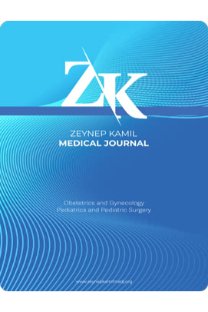Erken Membran Rüptürünün Preterm Bebeklerde Morbi̇di̇te ve Mortali̇te Üzeri̇ne Etki̇si̇ni̇n Araştırılması
Morbidity and Mortality of Premature Rupture of Membranes in Preterm Infants
___
- 1. Caughey AB, Robinson JN, Norwitz ER. Contemporary diagnosis and management of preterm premature rupture of membranes. Rev Obstet Gynecol 2008; 1:11-22.
- 2. 1. ACOG practice bulletin. Premature rupture of membranes. Clinical management guidelines for obstetrician-gynecologists. Number 1, June 1998. American College of Obstetricians and Gynecologists. Int J Gynaecol Obstet 1998; 63: 75-84.
- 3. Roberts WE, Morrison JC, Cheryl H, Wiser WL: The incidence of preterm labor and specific risk factors. ObstetGynecol 1990;76: 85S-89S
- 4.Daikoku NH, Kaltreider DF, Johnson TR Jr, Johnson JW, Simmons MA. Premature rupture of membranes and preterm labor: neonatal infection and perinatal mortality risks. Obstet Gynecol 1981; 58:417-25.
- 5. Fayez JA, Hasan AA, Jonas HS, et al.Management of premature rupture of the membranes. Obstet Gynecol 1978; 52:17-21.
- 6. American College of Obstetricians and Gynecologist. Premature Rupture of Membranes. Washington, DC: American College of Obstetricians and Gynecologist;1988. ACOG Practice Bulletin No. 1.
- 7. ACOG Committee on Practice BulletinsObstetrics. ACOG Practice Bulletin No. 80: Premature rupture of the membranes. Clinical management guidelines for obstetrician-gynecologists. Obstet Gynecol 2007; 109:1007-19.
- 8. Dale PO, Tanbo T, Bendvold E, Moe N. Duration of the latency period in preterm premature rupture of the membranes. Maternal and neonatal concequences of expectant management. Eur J Obstet Gynecol reprod Biol 1989; 30:257-62.
- 9. Edwards MS, Baker CJ. Sepsis in the newborn. In: Gershon AA, Hotez PJ, Katz SL (eds): Krugmans Infectious Diseases of Children (11th ed). 2004; 545-56.
- 10. Duff P. Premature rupture of the membranes in term patients. Semin Perinatol 1996; 20:401-8.
- 11. Gerdes JS. Diagnosis and management of bacterial infections in the neonate. Pediatr Clin N Am 2004; 51:939-59.
- 12. Hannah ME, Ohlsson A, Farine D, et al. Induction of labor compared with expectant management for prelabor rupture of membranes at term. TERMPROM Study Group. N Engl J Med 1996; 334:1005-10.
- 13. Pankuch GA, Appelbaum PC, Lorenz RP, Botti JJ, Schachter J, Naeye RL. Placental microbiology and histology and the pathogenesis of chorioamnionitis. Obstet Gynecol 1984;64:802806. 4. Smulian JC, ShenSchwarz S, Vintzileos AM, Lake MF, Ananth CV. Clinical chorioamnionitis and histologic placental inflammation. Obstet Gynecol 1999;94:1000 1005.
- 14. Dollner H, Vatten L, Halgunset J, Rahimipoor S, Austgulen R. Histologic chorioamnionitis and umbilical serum levels of pro-inflammatory cytokines and cytokine inhibitors. Br J Obstet Gynaecol 2002;109:534 539.
- 15. Pacora P, Chaiworapongsa T, Maymon E, Kim YM, Gomez R, Yoon BH, et al. Funisitis and chorionic vasculitis: the histological counterpart of the fetal inflammatory response syndrome. J Matern Fetal Neonatal Med 2002;11:1825.
- 16. Gomez R, Romero R, Ghezzi F, Yoon BH, Mazor M, Berry SM. The fetal inflammatory response syndrome. Am J Obstet Gynecol 1998;179:194202.
- 17. Watterberg KL, Demers LM, Scott SM, Murphy S. Chorioamnionitis and early lung inflammation in infants in whom bronchopulmonary dysplasia develops. Pediatrics 1996;97:210215.
- 18. Yoon BH, Romero R, Jun JK, Park KH, Park JD, Ghezzi F et al. Amniotic fluid cytokines (interleukin-6, tumor necrosis factoralpha, interleukin-1 beta, and interleukin-8) and the risk for the development of bronchopulmonary dysplasia. Am J Obstet Gynecol 1997;177:825830.
- 19. Groneck P, Götze-Speer B, Oppermann M, Eiffert H, Speer CP. Association of pulmonary inflammation and increased microvascular permeability during the development of bronchopulmonary dysplasia: a sequential analysis of inflammatory mediators in respiratory fluids of high-risk preterm neonates. Pediatrics 1994;93:712718.
- 20. Northway WH Jr, Rosan RC, Porter DY. Pulmonary disease following respiratory therapy of hyaline membrane disease. Bronchopulmonary dysplasia. N Engl J Med 1967; 276: 357-68.
- 21. Dammann O, Brinkhaus MJ, Bartels DB, Dordelmann M, Dressler F, Kerk J et al. Immaturity, perinatal inflammation, and retinopathy of prematurity: a multi-hit hypothesis. Early Hum Dev 2009;85:325-329
- 22. Kaltreider DF, Kahl S. Epidemiology of preterm delivery. Clin Obstet Gynecol 1980; 23:17-21
- 23. Edwards MS, Baker CJ. Sepsis in the newborn. In: Gershon AA, Hotez PJ, Katz SL (eds): Krugmans Infectious Diseases of Children (11th ed). 2004; 545-56.
- 24. Daikoku NH, Kaltreider DF, Johnson TR Jr, Johnson JW, Simmons MA. Premature rupture of membranes and preterm labor: neonatal infection and perinatal mortality risks. Obstet Gynecol 1981; 58:417-25.
- ISSN: 1300-7971
- Yayın Aralığı: 4
- Başlangıç: 1969
- Yayıncı: Ali Cangül
Leyla D. KOLSUZ, Bilge DEMİREL, Tuğba GÜRSOY, Güner KARATEKİN, Fahri OVALI
Endometrial Polip Ön Tanılı Hastalarda Histeroskopi Sonuçlarımız
HASAN TERZİ, Ahmet KALE, M.Akif SARGIN
-Postmenapozal Nadi̇r Görülen Bi̇r Over Tümörü: Endometri̇oi̇d Ki̇stadenofi̇brom (Olgu Sunumu)
SÜLEYMAN MURAT BAKACAK, Özge KIZILKALE, RUKSET ATTAR, Gazi YILDIRIM, M. Sühha BOSTANCI, Elif BAĞLAM, Cem FIÇICIOĞLU
İskelet Displazilerine Yaklaşım ve Tanımları ZKTB
Özge KIZILKALE, MUSTAFA EROĞLU, Gazi YILDIRIM, SÜLEYMAN MURAT BAKACAK, M. Sühha BOSTANCI, RUKSET ATTAR, Zeynep BAKACAK, Cem FIÇICIOĞLU
Body Stalk Anomalisi : Olgu Sunumu
Mesut POLAT, Resul ARISOY, Emre ERDOĞDU, Özgür Aydın TOSUN, Resul KARAKUŞ, Oya PEKİN, Ahmet Semih TUĞRUL
Emine AKSOY, Alanur Menekşe GÜVEN, Müşerref Sultan MERMER, GÖKHAN CÜCE, Hasan Ali İNAL
Spontan Üçüz Bir Gebelikte Yapışık İkiz
SÜMEYRA NERGİZ AVCIOĞLU, Baran Özhan BAYKAL, SÜNDÜZ ÖZLEM ALTINKAYA, Hasan YÜKSEL, Mert KÜÇÜK, SELDA DEMİRCAN SEZER
ŞULE AYLA, Gülperi ÖKTEM, GAMZE TANRIVERDİ, Ayhan BİLİR
İncebarsak Mezosunda RIA: Nadir Bir Olgu
Zehra Nihal DOLGUN, Rakhshanda ASLANOVA, Emrah TURHAN, Niyazi Cenk SAYIN
